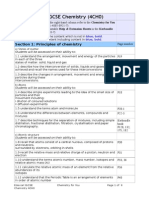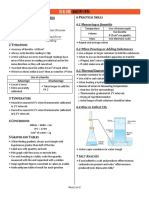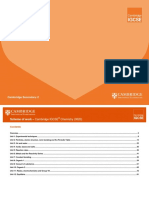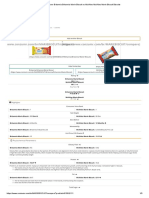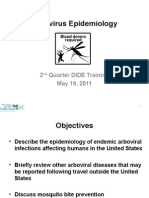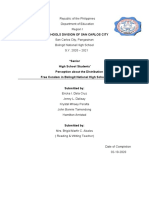Revisions Checklist For IGCSE Biology 0610 FINAL
Revisions Checklist For IGCSE Biology 0610 FINAL
Uploaded by
Danil PanciCopyright:
Available Formats
Revisions Checklist For IGCSE Biology 0610 FINAL
Revisions Checklist For IGCSE Biology 0610 FINAL
Uploaded by
Danil PanciOriginal Title
Copyright
Available Formats
Share this document
Did you find this document useful?
Is this content inappropriate?
Copyright:
Available Formats
Revisions Checklist For IGCSE Biology 0610 FINAL
Revisions Checklist For IGCSE Biology 0610 FINAL
Uploaded by
Danil PanciCopyright:
Available Formats
Revision Checklist for IGCSE Biology 0610
Guide for Students
REVISION CHECKLIST for IGCSE Biology 0610 A guide for students How to use this guide The guide describes what you need to know about your IGSCE Biology examination. It can be used to help you to plan your revision programme for the theory examinations and will explain what the examiners are looking for in the answers you write. It can also be used to help you revise by using the tick boxes in Section 3, What you need to know?, to check what you know and which topic areas of Biology you have covered. The guide contains the following sections: Section 1 - How will you be tested? This section will give you information about the different types of theory and practical examination Papers that are available.
Section 2 - What will you be tested on? This section describes the areas of knowledge, understanding and skills that you will be tested on.
Section 3 - What you need to know This shows the syllabus content in a simple way so that you can check: the topics you need to know about how the Extended syllabus (Supplement) differs from the Core syllabus details about each topic in the syllabus how much of the syllabus you have covered
Section 4 - Appendices This section covers the other things you need to know, including: information about the mathematical skills you need information about terminology, units and symbols, and the presentation of data the importance of the command words the Examiners use in the examination papers Not all the information will be relevant to you. For example, you will need to select what you need to know in Sections 1 and 3, by finding out from your teacher which examination Papers you are taking.
Section 1 - How will you be tested? 1.1 The examinations you will take You will be entered for three examination Papers, two theory Papers and one practical Paper. You will need to ask your teacher which practical Paper you are taking. Nearer the time of the examination, you will also need to ask which theory Papers you are being entered for. If your teacher thinks that you should enter for the examination based on the Core syllabus, you will take Paper 1 (theory), Paper 2 (theory) and one of the practical Papers (4 or 5 or 6). If your teacher thinks that you should enter for the examination based on the Extended syllabus, you will take Paper 1 (theory), Paper 3 (theory) and one of the practical Papers (4 or 5 or 6). Whether you take Paper 2 or 3 will depend on the progress your teacher thinks you have made and which Paper most suits your particular strengths. You should discuss this with your teacher. 1.2 About the theory Papers The table gives you information about the theory Papers Paper number How long and how many marks? 45 minutes (40 marks) Whats in the paper? Whats the % of the total marks 30%
Paper 1
40 multiple-choice questions. You choose one answer you consider correct from a choice of 4 possible answers. Short-answer questions and structured questions. You should write your answers in the spaces provided. The Paper tests the Core syllabus. Short-answer questions and structured questions. You should write your answers in the spaces provided. The Paper tests topics in both the Core and Extended syllabus. see next table
Paper 2
1 hours (80 marks)
50% (you do either Paper 2 or Paper 3)
Paper 3
1 hours (80 marks)
50% (you do either Paper 2 or Paper 3)
Practical Paper
see next table
20% Total 100%
1.3 About the practical Papers Twenty percent of the marks for IGCSE Biology are for practical work. Practical work is based only on the Core syllabus. You will do one of the practical Papers shown in the table. Your teacher will tell you which practical Paper you will do. The number of marks varies between the Papers but your final mark will be calculated so that it is worth same percentage of the total examination as the other practical Papers.
Paper number and type Paper (coursework) 4
How long and what its marked out of? no fixed time (48 marks)
Whats involved?
You design and carry out experiments, which are then marked by your teacher. You will be assessed on 4 skill areas. You need to produce 2 pieces of work for each skill area. You do a practical exam, which is supervised by a teacher. There are usually 2 questions testing 4 skill areas. You answer a written paper about practical work. There are usually 6 questions, which test the same skill areas as Paper 5. If you are unsure of
Paper 5 (practical test) Paper (alternative practical) 6 to
1 hours marks)
(40
1 hour (60 marks)
Here is some more detail about each of the practical Papers. anything, ask your teacher. 1.3.1 Paper 4 (Coursework)
You will carry out several experiments throughout your Biology course, which will be marked by your teacher. Your teacher will mark you on four different skill areas (Using apparatus, Observing, Handling results, Planning and Evaluating.) What you have to do to get a basic (B), medium (M) or high (H) mark is shown below. The differences between basic, medium and high marks are shown below in italics and underlined. Skill C1: Using apparatus You follow written instructions to set up and use apparatus correctly. You carry out your work safely. B: You follow instructions correctly to do a single practical operation e.g. testing a sample of Food to find out if it contains starch. You use familiar apparatus with a little help on points of safety.
M:
You follow instructions correctly to do a series of step-by-step practical operations e.g. testing a leaf to find out if it contains starch or investigate the digestion of starch by amylase You use familiar apparatus fairly well with no help on points of safety
H:
You follow instructions correctly to do a series of step-by-step practical operations, but you may need to change one step if things dont work out as you thought e.g. lower the concentration of amylase if the digestion of starch goes too fast. You use familiar apparatus very well with no help on points of safety.
Skill C2: Observing You make observations and measurements and write them down clearly. B: You make suitable observations when given some detailed instructions. You record results correctly when given a detailed table or some help. You make suitable observations when given minimal instructions. You record results correctly when given an outline table or minimal help. You make suitable observations without help and record results as accurately as the apparatus allows. You record results correctly without help.
M:
H:
Skill C3: Handling results You draw graphs and/ or perform calculations from your results. You draw conclusions from your results and recognize any results, which do not fit into the pattern. B: You draw graphs or charts (or do some calculations) from your results when given detailed suggestions. You draw simple conclusions from your results. M: You draw graphs or charts (or do some calculations) from your results when given only a little help. You draw simple conclusions from your results and comment on the patterns shown by the data e.g. a high concentration of amylase causes a faster rate of reaction than a low concentration. You comment on results which do not fit the pattern. H: You draw graphs or charts (or do some calculations) from your results when given no help. You draw more general conclusions from your results and comment on the patterns, e.g. the greater the concentration of amylase, the faster the reaction. You comment on results which do not fit the pattern and suggest how to deal with them e.g. ignore them.
You suggest what errors there are in your experiment.
Skill C4: Planning and evaluating You plan your experiment given some basic information from your teacher. You suggest how well your plan worked and modify if necessary. B: You write a simple plan for your experiment. You modify your plan after doing several experiments to see which works the best. M: You write a plan for your experiment, which has a series of logical steps in it. You modify your plan after doing trial experiments and give reasons why you need to alter your original plan. If there are two variables (things which can change e.g. concentration of amylase, concentration of starch), you recognise that one variable needs to be changed, while the other is kept the same. E.g. keep the concentration of starch the same but vary the concentration of amylase. You write a plan for your experiment which has a series of logical and clearly reasoned steps. You modify your plan after doing trial experiments and give reasons why you need to alter your original plan and suggest to what extent your plan works and why. You suggest how to deal with unexpected results. If there are more than two variables you recognise which need to be controlled (kept constant) and which needs to be changed.
H:
1.3.2 Paper 5 (Practical test) You do a practical exam, which is supervised by a teacher. You are given an instruction sheet which enables you carry out the experiments, handle the data and draw appropriate conclusions. You may be asked to use the following techniques: carefully following a set of instructions in a particular order using familiar and unfamiliar methods to record observations and making deductions from them performing simple tests, for example tests for food substances, using hydrogen carbonate indicator, litmus and Universal Indicator paper o using a scalpel or razor blade, forceps, scissors and mounted needles skilfully o using a hand lens to observe and record biological specimens o making clear line drawings of specimens o performing simple arithmetical calculations, including the magnification of a drawing 1.3.3 Paper 6 (Alternative to practical) This is a written Paper, testing the same four skills as Paper 5. You may be asked to: carefully follow a set of instructions in a particular order use familiar and unfamiliar methods to record observations and making deductions from them perform simple tests, for example tests for food substances, using hydrogen carbonate indicator, litmus and Universal Indicator paper o use a scalpel or razor blade, forceps, scissors and mounted needles skilfully o use a hand lens to observe and record biological specimens o make clear line drawings of specimens o perform simple calculations, including the magnification (enlargement) of a drawing
Section 2 - What will you be tested on? The Examiners will take account of the following areas in your examination Papers: your knowledge (what you remember) and understanding (how you use what you know and apply it to unfamiliar situations) how you handle information and solve problems your use of experimental skills
These areas of knowledge and skills are called Assessment Objectives. The theory Papers test mainly Assessment Objectives A (knowledge with understanding) and Assessment Objective B (handling information and problem solving). The purpose of the practical Paper is to test Assessment Objective C (experimental skills). Your teacher will be able to give you more information about how each of these is used in the examination Papers. The table shows you the range of skills you should try to develop: Skill A: knowledge with understanding What the means skill What you need to be able to do 1. use scientific ideas, facts and laws 2. know scientific definitions e.g. what is excretion? 3. know about biological apparatus and how it works 4. know about S I units, quantities (e.g. mass) and symbols (e.g. dm3) 5. understand the importance of science in everyday life 1. select and organize information from graphs, tables and written text 2. change information from one form to another, e.g. draw chart and graphs from data 3. arrange data and carry out calculations 4. identify patterns from information given and draw conclusions 5. explain scientific relationships, e.g. changes in heart rate in relation to activity 6. make predictions and develop scientific ideas 7. solve problems 1. set up and use apparatus safely 2. make observations and measurements and record them 3. analyse experimental results and suggest how valid they are 4. plan and carry out your own experiment and describe to what extent your plan worked
remembering facts and applying these facts to new situations
B: handling information and problem solving
how you extract information and rearrange it in a sensible pattern and how you carry out calculations and make predictions
C: experimental skills
planning and carrying out experiments and recording and analysing information
Section 3 - What you need to know This is a table, which describes the things you may be tested on in the examination. It is arranged in 14 topic areas. If you are studying only the Core material (Papers 1 and 2), you will need to refer only to the column headed Core material. If you are studying the Extended syllabus (Papers 1 and 3), you will need to refer to both the Core and Extended material columns. If you are unsure about which material to use, you should ask your teacher for advice. How to use the table You can use the table throughout your course to check the topic areas you have covered. You can also use it as a revision aid. When you think you have a good knowledge of a topic, you can tick the appropriate box in the checklist column. The main headings in the topic areas are usually followed by the details of what you should know. Test yourself as follows: cover up the details with a piece of paper try to remember the details when you have remembered the details correctly, put a tick in the appropriate box
If you use a pencil to tick the boxes, you can retest yourself whenever you want by simply rubbing out the ticks. If you are using the table to check the topics you have covered, you can put a tick in the topic column next to the appropriate bullet point. The column headed Comments can be used: to add further information about the details for each bullet point to add learning aids to highlight areas of difficulty/ things which you need to ask your teacher about
Topic Section I 1. Features of living organisms
Core material You should be able to:
Checklist
Comments
Extended material You should be able to:
Checklist
Comments
list and describe the features of living organisms state the meaning of the terms: nutrition excretion respiration growth movement reproduction sensitivity explain the meaning of and describe the binomial (two name) system of naming species, e.g. Felis leo and Felis tigris identify and name the five main classes of vertebrates by using visible, external features only
2.1. The idea and use of a classification system
2.2 Adaptations of organisms to their environment
List the main, visible, external features used to identify and name the groups, also name examples: o Flowering plants (monoand dicotyledons) arthropods (insects, arachnids, crustaceans and myriapods) annelids nematodes molluscs
list the main features used to identify and name the groups, also list their adaptation to the environment as appropriate. o o o viruses bacteria fungi
o o o 3.Simple keys
use simple dichotomous (forked) keys that use easily identified features
Topic Section III 1. Reproduction
Core Material You should be able to:
Checklist
Comments
Extended Material You should be able to:
Checklist
Comments
1.1 Asexual reproduction
understand that asexual reproduction is the production of new individuals of the same type / species by one parent
consider the advantages and disadvantages to a species of asexual reproduction
describe asexual reproduction in o o o bacteria spore production in fungi tuber formation in potatoes consider the advantages and disadvantages to a species of sexual reproduction
1.2 Sexual reproduction
understand that sexual reproduction is the production of new individuals of the same type / species by the fusing together of gametes from two parents
1.2.1 Sexual reproduction in plants
describe the structure and functions of the flower of a named dicotyledonous plant understand that pollination is the transfer of pollen from an anther to a stigma name agents pollination of consider the implications to a species of self-pollination cross-pollination
compare the different structural adaptations of o o o o o o insect-pollinated flowers wind-pollinated flowers describe the growth of the pollen tube process of fertilisation formation of seed and fruit structure of a nonendospermic fruit
understand that dispersal of seeds and fruits is the carriage of these away from the parent plant describe seed and fruit dispersal by o o wind animals
1.2.2 Sexual reproductio n in humans
describe the structure and functions of the reproductive system of the human o male o female describe the menstrual cycle female
describe o sexual intercourse o fertilisation o implantation describe the development of the fetus in terms of o placenta o maternal and fetal blood supplies exchange of materials describe ante-natal care in terms of o dietary needs of the mother o maintaining good health describe birth outline the functions of the o amniotic sac o amniotic fluid
describe the advantages of breast-feeding compared with bottle-feeding
1.3 Sex hormones
describe the roles, in the development and regulation of secondary sexual characteristics at puberty, of o testosterone o oestrogen
describe the sites of production and the roles of oestrogen and progesterone in o the menstrual cycle o pregnancy
1.4 Methods of birth control
name and describe the following methods of birth control o natural o chemical o mechanical o surgical describe the signs, symptoms, effects and treatment of gonorrhoea describe for human immunodeficiency virus (HIV) the methods transmission of
consider the social aspects of o artificial insemination o the use of hormones in fertility drugs
1.5 Sexually transmissibl e diseases
outline how HIV affects the immune system
the ways in which it can be prevented from spreading
2. Growth and developme nt
understand that growth can be measured by the increase in dry mass of an organism understand that development can be judged by the increase in complexity of an organism describe the environmental conditions that affect germination understand that inheritance is the transfer of genetic information from one generation to the next, and that this leads to both continuity and variation within a species understand the following terms o a chromosome is a thread like structure in the nucleus of a cell that carries genes a gene is a unit of inherited information on a chromosome that controls an inherited feature e.g. eye colour
3. Inheritance
3.1 Chromoso mes
alleles are forms of a gene that control different versions of a feature e.g. blue eye colour or brown eye colour a haploid nucleus is one that has one copy of each of the different chromosomes that exist for a species a diploid nucleus is one that has a pair of copies of each of the different chromosomes that exist for a species
describe the inheritance of sex in humans (XX and XY sex chromosomes) describe mitosis simply (no details of stages needed) in terms of exact duplication chromosomes of
3.2 Mitosis
3.3 Meiosis
producing identical diploid daughter nuclei describe the production of gametes by meiosis simply (no details of
stages needed) in terms of halving of chromosome number producing variation in the haploid daughter nuclei understand the terms gene and allele and additionally the following terms genotype is the alleles an individual has phenotype is the observable feature of an individual homozygous is having two identical alleles for a feature heterozygous is having two different alleles for a feature a dominant allele is one which when present always affects the phenotype a recessive allele is one which only affects the phenotype if it is the only explain codominance the inheritance of A, B, AB and O blood groups (IA, IB and IO)
3.4 Monohybrid inheritance
describe sickle cell anaemia its occurrence linked to that of malaria
type of allele present calculate and predict the results of monohybrid crosses involving 1 : 1 ratios 3 : ratios describe continuous and discontinuous variation, illustrated by height and A, B, AB and O blood groups, as affected by o the environment o genes understand that mutation is a change in the genes or chromosomes of an individual describe mutation as a source of variation, e.g. Downs syndrome outline the effects, on the rate of mutation, of o radiation o chemicals describe variation understand that competition leads to differential survival of, and reproduction by, those organisms best fitted to the environment
3.5 Variation
3.6 Selection
describe the role of artificial selection in producing varieties of animals and plants with increased economic importance understand that natural selection involves the transfer of genes by the best adapted organisms to their offspring
consider the importance of natural selection as a possible mechanism for evolution
3.7 Genetic engineering
understand that genetic engineering is the transfer of a gene from one species into another species
describe the development of strains of antibiotic resistant bacteria, as an example of natural selection explain why human insulin genes were put into bacteria outline how this is achieved using genetic engineering
Topic Section IV 1.Energy flow
Core Material You should be able to:
Checklist
Comments
Extended Material You should be able to:
Checklist
Comments
state that the Sun is the principal source of energy input to biological systems. describe the non-cyclical nature of energy flow
2. Food chains and food webs
understand the following terms o a food chain shows links between a series of organisms feeding on one another a food web shows a group of interlinked food chains producers are green plants that produce their own food by photosynthesis consumers are organisms that depend on the food produced by plants herbivores (primary consumers) obtain their energy by feeding directly on producers carnivores (secondary consumers) obtain their energy by feeding on herbivores or (tertiary consumers) on other carnivores decomposers are microorganisms that feed on the dead remains of animals and plants
understand that there is o o increased efficiency in supplying green plants as human food relative inefficiency, in terms of energy loss, in feeding crop plants to animals
o o
3. Nutrient cycles
an ecosystem is an area and the organisms that live in that area trophic level is the position an organism occupies in a food chain. Trophic level 1 is always the producers describe o o energy loss between trophic levels the advantages of short food chains
describe the nitrogen cycle in terms of the roles of microorganisms (names of individual bacteria are not needed) and other processes producing usable nitrogen containing substances by decomposition and by nitrogen fixation in roots absorption of these substances by plants and their conversion into protein the passage of protein through food chains death and decay nitrification denitrification return of nitrogen to the soil or atmosphere consider the effects, on the balance between oxygen and carbon dioxide, of o burning fossil fuels o cutting down of forests
describe and interpret pyramids of o o o biomass energy numbers
describe the o o carbon cycle water cycle
4. Population size
state the factors affecting the rate of population growth (food supply, predation, disease) describe their importance identify the phases of a sigmoid curve of population growth resulting from the action of a limiting factor describe the o increase in population size in the absence of limiting factors (human population) social implications of current human survival rate interpret graphs and diagrams of human population growth with emphasis on examples of international importance (e.g. tropical rain forests, oceans and rivers)
Explain the factors that lead, in the sigmoid curve of population growth, to the o o o lag phase exponential (log) phase stationary phase
o o o
5. Human influences on the ecosystem 5.1 Agriculture consider, using suitable examples, ways in which the use of modern technology has resulted in increased food production describe the undesirable effects of deforestation describe the overuse of fertilisers on
the land 5.2 Pollution describe the undesirable effects of o o o o water pollution by sewage and chemical waste air pollution by sulphur dioxide pollution by pesticides and herbicides pollution by nuclear fallout
consider the o significance of non-biodegradable plastics and other materials used in the manufacturing industry causes and apparent effects of acid rain measures that might be taken to reduce the incidence of acid rain
o o
5.3 Conservation
describe the need for conservation of o o o species their habitats natural resources
describe the principle of recycling materials including sewage (water) and paper
Section 4 - Appendices 4.1 The mathematical skills you need This is a checklist of the mathematical skills you need for your Biology examination. You should tick each box in the checklist when you know that you have learned the skill. Ask your teacher to explain any skill you are unsure about. The Comments column is for extra notes and examples. You can use a calculator for all the examination Papers. If your calculator is one that can be programmed, you should make sure that any information in it is removed before the examination. You should be able: add subtract multiply Checklist Comments
divide Use: averages decimals fractions percentages ratios reciprocals recognise standard notation (notation is putting symbols for numbers e.g. x = 2, y = 5, atomic mass, Z = 12) use standard notation use direct proportion (stepwise increases) use inverse proportion (inverse means turned up side down) use numbers to the power of 10 e.g. 1x102 = 100
the inverse of 4 is (= 0.25)
Your calculator will often show number to the power of 10 when you do calculations. Do not worry too much though your calculator does the work for you. You will be given the data
draw charts graphs with line of best fit
interpret: bar graphs pie charts line graphs select suitable scales and axes for graphs make approximations
use the formulas: area = length x width volume = length x width x height use and convert metric units into one another
e.g. 100cm = 1 m kg
1000g = 1
use mathematical and measuring instruments e.g. ruler, compasses, protractor
understand the meaning of : radius diameter square rectangle
4.2 Other important information you need for your Biology Examination The terms used in Biology examination Papers are given in the sections that follow. It is very important that you know and understand all of them before you take your examination. You should ask your teacher to explain anything that you are unsure about. 4.2.1. Numbers The decimal point will be placed on the line, e.g. 52.35. Numbers from 1000 to 9999 will be printed without commas or spaces. Numbers greater than or equal to 10 000 will be printed without commas. A space will be left between each group of three whole numbers, e.g. 4 256 789. 4.2.2 Units The International System of units will be used (SI units). Units will be indicated in the singular not in the plural, e.g. 28 kg.
(a) SI units commonly used in Biology are listed below. N.B. Care should be taken in the use of mass and weight. In most biological contexts, the term mass is correct, e.g. dry mass, biomass. Quantity length Name of unit kilometre metre centimetre millimetre micrometer Symbol for unit km m cm mm m
mass
tonne (1000 kg) kilogram gram milligram microgram
(no symbol) kg g mg g
time
year day hour minute second
y d h min s
amount of substance
mole
mol
(b)
Derived SI units are listed below. kilojoule joule obsolete) (calorie is kJ J
energy
(c) area
Recommended units for area, volume and density are listed below.
4 2
hectare square square square square
3 3
10 metre decimetre centimetre millimetre
3 3
ha
2
m cm mm
3
dm
2 2
volumecubic kilometre km cubic metre m cubic decimetre (preferred to dm litre) litre dm (not l) cubic centimetre cm (not ml) cubic millimetre mm
-3 -3
density kilogram per cubic metre
or kg m gram per cubic centimetre or g cm
d)
Use of Solidus
The solidus (/) will not be used for a quotient, e.g. m / s for metres per second.
4.2.3. Presentation of data The solidus (/) is to be used for separating the quantity and the unit in tables, graphs and charts, e.g. time/s for time in seconds. (a) Tables (i) Each column of a table will be headed with the physical quantity and the appropriate unit, e.g. time / s. There are three acceptable methods of stating units, e.g. metres per sec or m per s or -1 ms (ii) The column headings of the table can then be directly transferred to the axes of a constructed graph. (b) Graphs (i) The independent variable should be plotted on the x-axis (horizontal axis) and the dependent variable plotted on the y-axis (vertical axis). (ii) Each axis will be labelled with the physical quantity and the appropriate unit, e.g. time / s. (iii) The graph is the whole diagrammatic presentation. It may have one or several curves plotted on it. (iv) Curves and lines joining points on the graph should be referred to as 'curves'. (v) Points on the curve should be clearly marked as crosses (x) or encircled dots ( ). If a further curve is included, vertical crosses (+) may be used to mark the points.
(c)
Pie Charts These should be drawn with the sectors in rank order, largest first, beginning at 'noon' and proceeding clockwise. Pie Charts should preferably contain no more than six sectors.
(d)
Bar Charts These are drawn when one of the variables is not numerical, e.g. percentage of vitamin C in different fruits. They should be made up of narrow blocks of equal width that do not touch.
(e)
Column Graphs These are drawn when plotting frequency graphs from discrete data, e.g. frequency of occurrence of leaves with different numbers of prickles or pods with different numbers of seeds. They should be made up of narrow blocks of equal width that do not touch.
(f)
Histograms These are drawn when plotting frequency graphs with continuous data, e.g., frequency of occurrence of leaves of different lengths. The blocks should be drawn in order of increasing or decreasing magnitude and they should be touching.
4.2.4 Taxonomy Taxonomy is the study of the principles of the organisation of taxa into hierarchies. There are seven levels of taxon - kingdom, phylum, class, order, family, genus and species. These may be used when teaching the concept and use of a classificatory system, the variety of organisms, and the binomial system. The following should apply: (a) Five Kingdoms are now recognised as Prokaryotes (Prokaryotae), including bacteria and blue-green bacteria protoctists (Protoctista), including green, red and brown algae and protozoans fungi (Fungi) plants (Plantae) animals (Animalia) The (b) viruses cannot be fitted into this classificatory system.
The binomial system of naming gives each organism a two-word name. The first word is the generic name and the second word is the trivial name, e.g. Homo sapiens. The trivial name should never be used by itself. Generic and trivial names are distinguished from the rest of the text either by underlining (when written or typed) or by being set in italics (in print). The generic name always takes an initial capital letter. It can be accepted as a shorthand for the species name where the intent is obvious, e.g. Plasmodium, and in these circumstances can stand alone. The common name should not normally be written with an initial capital letter, e.g. cat and dog. The exception is Man, where it is the common name for a species where the two sexes are distinguished by the terms man and woman.
(c)
(d)
(e)
(f)
A species is not easy to define but an acceptable general definition is as follows. 'A group of organisms capable of interbreeding and producing fertile offspring.'
4.2.5. Genetics (a) The terms gene and allele are not synonymous. A gene is a specific length of DNA occupying a position called a locus. A specific function can be assigned to each gene. An allele is one of two or more different forms of a gene. (b) A standard form of presenting genetic crosses should be adopted. The following symbols should be used as shown. P designates the cross of pure-breeding (homozygous) individuals. F1 designates the offspring of homozygous parents. F2 designates the offspring produced by crossing F1 parents. The format for the course of a genetic cross should be labelled as shown. Parental phenotypes parental genotypes gametes offspring genotypes offspring phenotypes etc. The gene should be designated by a letter or letters so that upper and lower case versions are easily distinguishable, e.g. B and b. The upper case letter indicates the dominant allele and the lower case letter indicates the recessive allele. The symbols for gametes should be circled to indicate the discrete nature of each gamete. Some form of checkerboard should be used to demonstrate genotypes that can result from random fusion of gametes. Students should understand that genotypes are only possible combinations and that only a very large number of offspring can result in all combinations being achieved. The term incomplete dominance should be discontinued and in the particular case where alleles are equally dominant it should be called codominance. Thus codominance should be used where the influence of both alleles is shown in the phenotype, e.g. the AB blood group in humans.
(c)
(d)
(e)
(f)
(g)
4.2.6 Terminology (a) Wherever possible, English terms should be used in preference to Latin or Greek terms, e.g. the term red blood cell should be used and not erythrocyte. Generalised terms should be stated in English, e.g. small intestine. Where no suitable English terms exist, latinised terms are unavoidable and will need to be used, e.g. atrium, bronchi, villi.
(b) (c)
4.3 Command words and phrases used in Biology examination papers Examiners use command words to help you to understand what they are looking for in your answer. This table explains what each of these words or phrases means and will help you to understand the kind of answer you should write. The list of command words is in alphabetical order. You should remember that the meaning of a term may vary slightly according to how the question is worded. Calculate A numerical answer is needed. You should show any working, especially when there are two or more steps in a calculation. You should always include relevant units or symbols. e.g. calculate the magnification of a specimen This is used in a similar way to predict, except you will need to support your answer with a statement e.g. referring to a principle, or theory, or including reasoning with your prediction. You need to state the meaning of something e.g. respiration is the release of energy from food substances in living cells You need to state the main points about something (using labelled diagrams if this helps you). e.g. describe the parts played by the liver and the pancreas in the digestion of fats You may also be asked to describe a particular process e.g. describe how the pollination of a flower is brought about by insects You may be asked to describe how to do a particular experiment e.g. describe how you can test a food for starch and simple sugar This often indicates that the quantity cannot be directly measured but has to be found by calculation. E.g. Determine the amount of protein needed in a particular diet. You have to write down points for and against an argument e.g. discuss points for and against the use nitrogen fertilisers You need to work out an approximate value for a quantity, based on your knowledge of theory and the information provided. e.g. estimate the amount of energy needed by an office worker in a day. You may have to give reasons or refer to a theory depending on the context of the question. e.g. explain why the rate of transpiration changes with changes in light intensity This is a general term which can mean several similar things, such as calculate, measure, determine etc. See Explain Write down a number of separate points. Where the number of points is stated in the question, you should not write more than this number. e.g. list three features of insect-pollinated flowers See Understand
Deduce Define Describe
Determine
Discuss Estimate
Explain
Find Give a reason / reasons List
Meant (what is meant by the term) Measure
You are expected to find a quantity by using a measuring instrument e.g. length (by using a ruler), volume (by using a measuring cylinder)
Outline Predict
State the main points briefly e.g. outline the process of the water cycle This may be used in two ways: (i) You find the answer by working out the patterns in the information provided and drawing logical conclusions from this. E.g. predict the effect of the death of an organism in a food web on the populations of other food web members (ii) You may need to use information from tables and graphs or do calculations. e.g. predict the optimum temperature for lipase (i) When drawing graphs, this means that you may draw the approximate shape and/or position of the graph BUT you need to make sure that any important details, such as the line passing through the origin or finishing at a certain point, are drawn accurately. (ii) When drawing a specimen or other diagrams, a simple line drawing is all that is needed, but you must make sure the proportions are correct and the most important details are shown. You should always remember to label your diagrams. You should give a short answer without going into any detail, e.g. state the name of the mineral needed to make chlorophyll BUT, remember that state the meaning of is different. It is more like understand. This may be used in two ways: (i) There may be more than one correct answer to the question. e.g. suggest two reasons why a plants seeds should be widely dispersed (ii) You are being asked to apply your general knowledge of biology or reasoning skills to a topic area that is not directly on the syllabus e.g. applying ideas about competition and feeding relationships to a unfamiliar food web You should (i) define something and (ii) make a more detailed comment about it. The amount of detail depends on the number of marks awarded. e.g. what do you understand by the term digestion
Sketch
State
Suggest
Understand (what do you understand by the term?)
You might also like
- IGCSE Chemistry NotesDocument46 pagesIGCSE Chemistry NotesXamiya93% (59)
- IGCSE Physics Paper 6Document2 pagesIGCSE Physics Paper 6MithunSheregarNo ratings yet
- Igcse Chemistry Paper 6 RevisionDocument4 pagesIgcse Chemistry Paper 6 RevisionSarah Wong83% (6)
- IGCSE Chemistry - NotesDocument46 pagesIGCSE Chemistry - NotesJason Graves86% (7)
- Ophthalmology MCQ With AnswersDocument15 pagesOphthalmology MCQ With Answersj0ch5296% (110)
- Revision Checklist For ASA Level Biology 9700 FINALDocument52 pagesRevision Checklist For ASA Level Biology 9700 FINALSouna SmileNo ratings yet
- Biology Revision Edexcel IGCSEDocument17 pagesBiology Revision Edexcel IGCSEKyrziacos100% (1)
- Edexcel IGCSE ChemistryDocument11 pagesEdexcel IGCSE ChemistrySweetygirl_1650% (2)
- Biology Notes IGCSEDocument107 pagesBiology Notes IGCSERachel Adams100% (3)
- Igcse Revision GuideDocument33 pagesIgcse Revision GuideUtkarsh NautiyalNo ratings yet
- IGCSE Biology Paper 6 CardsDocument21 pagesIGCSE Biology Paper 6 CardsSara EmadNo ratings yet
- Activity 17 (Preparation of Salts)Document4 pagesActivity 17 (Preparation of Salts)Nkemzi Elias NzetengenleNo ratings yet
- Edexcel IGCSE Chemistry Student Book Answers PDFDocument58 pagesEdexcel IGCSE Chemistry Student Book Answers PDFmashiad84% (51)
- The Ultimate IGCSE Guide To BiologyDocument53 pagesThe Ultimate IGCSE Guide To BiologyAbdul Raheem100% (1)
- IGCSE ChemistryDocument25 pagesIGCSE ChemistryDeyala Mark83% (18)
- Biology Revision Notes Part1Document10 pagesBiology Revision Notes Part1volvanskyNo ratings yet
- IGCSE Biology RevisionDocument88 pagesIGCSE Biology RevisionAlex Parkinson100% (3)
- (Z-Notes) As Level - Chemistry Practical - NotesDocument2 pages(Z-Notes) As Level - Chemistry Practical - NotesRida Nadeem Sheikh75% (4)
- Notes To Study For Chemistry Paper 6Document8 pagesNotes To Study For Chemistry Paper 63abood51467% (6)
- IGCSE (Complete Biology) Chapter 1Document16 pagesIGCSE (Complete Biology) Chapter 1Hubbak Khan85% (13)
- GCSE/IGCSE Chemistry Question Bank With AnswersDocument347 pagesGCSE/IGCSE Chemistry Question Bank With AnswersVenkatesh Rao93% (67)
- Chemistry P3 Practical TipsDocument4 pagesChemistry P3 Practical TipsSashank Aryal83% (6)
- Igcse Revision Guide Questions (Bio)Document222 pagesIgcse Revision Guide Questions (Bio)PrateekRonaldo85% (13)
- Biology NotesDocument154 pagesBiology NotesMarwan YasserNo ratings yet
- EdExcel IGCSE Chemistry Past Paper Questions 2013Document320 pagesEdExcel IGCSE Chemistry Past Paper Questions 2013Sadiq Amin57% (7)
- Notes Full Biology (IGCSE) 2018Document225 pagesNotes Full Biology (IGCSE) 2018Sophia Bugs100% (2)
- Unit 6 NotesDocument6 pagesUnit 6 Noteseeshvari50% (4)
- Chemistry: Revising For Your Chemistry ExamsDocument10 pagesChemistry: Revising For Your Chemistry ExamsAhmed MohammedNo ratings yet
- IGCSE Chemistry SOW 2016Document85 pagesIGCSE Chemistry SOW 2016ashathtNo ratings yet
- IGCSE Biology NotesDocument15 pagesIGCSE Biology NotesCrystal Wong100% (14)
- Gcse Chemistry Revision Notes 2012Document72 pagesGcse Chemistry Revision Notes 2012Howaida100% (2)
- Chapter 1: Movement and PositionDocument12 pagesChapter 1: Movement and Positionailsa3leungNo ratings yet
- Notes To Study For Physics Paper 6Document7 pagesNotes To Study For Physics Paper 6Mohammad Nafai75% (4)
- Revision Guide Biology IDocument9 pagesRevision Guide Biology IAlison100% (1)
- Igcse Biology 2016 PDFDocument92 pagesIgcse Biology 2016 PDFNerea100% (1)
- AS Biology Revision Pack UNIT 2Document16 pagesAS Biology Revision Pack UNIT 2George Noorland100% (2)
- 9700 Biology Practical BookletDocument28 pages9700 Biology Practical BookletAdam WynnNo ratings yet
- Caie As Chemistry 9701 Practical PDFDocument6 pagesCaie As Chemistry 9701 Practical PDFNandish ShahNo ratings yet
- Notes To Study For Chemistry Paper 6Document11 pagesNotes To Study For Chemistry Paper 6sakibsultan_308100% (1)
- O Level Biology Practice Questions And Answers EnzymesFrom EverandO Level Biology Practice Questions And Answers EnzymesRating: 5 out of 5 stars5/5 (1)
- O Level Biology Practice For Structured Questions Transport In HumansFrom EverandO Level Biology Practice For Structured Questions Transport In HumansNo ratings yet
- O Level Biology Practice For Structured Questions RespirationFrom EverandO Level Biology Practice For Structured Questions RespirationRating: 4 out of 5 stars4/5 (2)
- O Level Chemistry Structured Practice Papers 9From EverandO Level Chemistry Structured Practice Papers 9Rating: 5 out of 5 stars5/5 (1)
- O Level Biology Practice For Structured Questions HomeostasisFrom EverandO Level Biology Practice For Structured Questions HomeostasisRating: 5 out of 5 stars5/5 (1)
- O Level Biology Practice Questions And Answers Transport In PlantsFrom EverandO Level Biology Practice Questions And Answers Transport In PlantsNo ratings yet
- O Level Biology Practice Questions And Answers HomeostasisFrom EverandO Level Biology Practice Questions And Answers HomeostasisRating: 5 out of 5 stars5/5 (1)
- O Level Biology Practice Questions And Answers Plant NutritionFrom EverandO Level Biology Practice Questions And Answers Plant NutritionRating: 5 out of 5 stars5/5 (1)
- O Level Biology Practice Questions And Answers CellsFrom EverandO Level Biology Practice Questions And Answers CellsRating: 5 out of 5 stars5/5 (2)
- A Simple Approach To Shared Decision Making in Cancer ScreeningDocument6 pagesA Simple Approach To Shared Decision Making in Cancer ScreeningariskaNo ratings yet
- Journal v12 n1 2020Document120 pagesJournal v12 n1 2020Fakhrizal AkbarNo ratings yet
- Macular HoleDocument21 pagesMacular HoleShashikiran SNo ratings yet
- Veterinary ProtozoologyDocument43 pagesVeterinary Protozoologywarda100% (1)
- Compare Britannia Britannia Marie Biscuit Vs McVities McVities Marie Biscuit BiscuitsDocument3 pagesCompare Britannia Britannia Marie Biscuit Vs McVities McVities Marie Biscuit BiscuitsmohitranaupscNo ratings yet
- C11 PDFDocument20 pagesC11 PDFamitkundu9No ratings yet
- Answers To Case 4: Folic Acid DeficiencyDocument2 pagesAnswers To Case 4: Folic Acid Deficiencyhttps://medical-phd.blogspot.comNo ratings yet
- Neuro - AUDocument56 pagesNeuro - AUnaimah noviantiNo ratings yet
- Journal of Orthopaedic Translation: Pauline Po Yee Lui, Patrick Shu Hang YungDocument11 pagesJournal of Orthopaedic Translation: Pauline Po Yee Lui, Patrick Shu Hang YungHector CarreonNo ratings yet
- 152 409 1 PBDocument2 pages152 409 1 PBRendra Syani Ulya FitriNo ratings yet
- Arbovirus EpidemiologyDocument48 pagesArbovirus EpidemiologyEdward ChavezNo ratings yet
- Cpcsea Guidelines For Laboratory AnimalsDocument7 pagesCpcsea Guidelines For Laboratory AnimalsAlok KumarNo ratings yet
- Soal Bahasa InggrisDocument12 pagesSoal Bahasa InggrisAlan TolohNo ratings yet
- Synergistic Effect of Newly Introduced Root Canal Medicaments Ozonated Olive Oil and Chitosan Nanoparticles, Against Persistent Endodontic PathogensDocument11 pagesSynergistic Effect of Newly Introduced Root Canal Medicaments Ozonated Olive Oil and Chitosan Nanoparticles, Against Persistent Endodontic Pathogensatia.nurulNo ratings yet
- Bates Physical Examination RED NOTESDocument2 pagesBates Physical Examination RED NOTESAmanda Gomez100% (1)
- Anesthesia For The Trauma PatientDocument48 pagesAnesthesia For The Trauma PatientÐr SalmaNo ratings yet
- 5 - Cardio Batch 2016 AnsweredDocument8 pages5 - Cardio Batch 2016 AnsweredCaroline AgathaNo ratings yet
- La Fontaine and Oyebode, 2014Document40 pagesLa Fontaine and Oyebode, 2014futurelai047No ratings yet
- Leukemia Case StudyDocument3 pagesLeukemia Case StudyMaria Victoria A. PraxidesNo ratings yet
- Salivary Gland ImagingDocument113 pagesSalivary Gland ImagingAME DENTAL COLLEGE RAICHUR, KARNATAKANo ratings yet
- Nphcda 2019 Annual Programme ReportsDocument127 pagesNphcda 2019 Annual Programme ReportsDarlingtonNo ratings yet
- Culture MediaDocument9 pagesCulture MediaBryan Mad'zNo ratings yet
- Schools Division of San Carlos CityDocument3 pagesSchools Division of San Carlos CityRoldan Dela CruzNo ratings yet
- BATHE TechniqueDocument3 pagesBATHE TechniqueYan Sheng HoNo ratings yet
- Fluor U&O Project Fall Protection and Working at Heights TrainingDocument68 pagesFluor U&O Project Fall Protection and Working at Heights TrainingjhoniNo ratings yet
- MS1 Course Task CU4 - ReyDocument2 pagesMS1 Course Task CU4 - ReyJeelian ReyNo ratings yet
- Health Insurance Product - Current Adamjee Life 2019Document6 pagesHealth Insurance Product - Current Adamjee Life 2019fatima khanzadaNo ratings yet
- Clinical Pathology MCQDocument14 pagesClinical Pathology MCQhshshhsjsjsbxxhNo ratings yet
- Peter Navarro Memo - January 29, 2020Document7 pagesPeter Navarro Memo - January 29, 2020Eric L. VanDussenNo ratings yet








